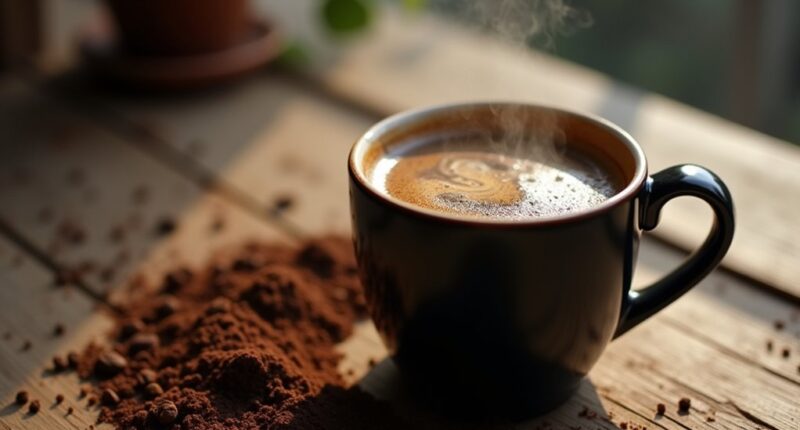If your coffee’s tasting like dirt, you’re likely dealing with some culprits! Stale beans can kick your brew’s flavor into the gutter, and hard water might be dulling those tasty notes. Plus, an unclean coffee maker? That’s the ultimate flavor assassin. Remember, using fresh beans and clean gear is key. Oh, and watch that grind size – too fine could turn your cup bitter! Curious about more ways to elevate your coffee game? There’s plenty more to explore!
At a Glance
- Over-roasting coffee beans can create a “dirt-like” flavor; opt for a light or medium roast for brighter notes.
- Using hard water can dull flavors; aim for balanced mineral content and a pH between 6.5 and 7.5.
- Old or stale coffee beans may impart unpleasant flavors; grind fresh beans just before brewing for optimal taste.
- An incorrect coffee-to-water ratio can lead to imbalanced flavors; follow recommended measurements for best results.
- Residue from unclean equipment can affect taste; establish a regular cleaning schedule to maintain flavor quality.
Cleaning Your Coffee Equipment
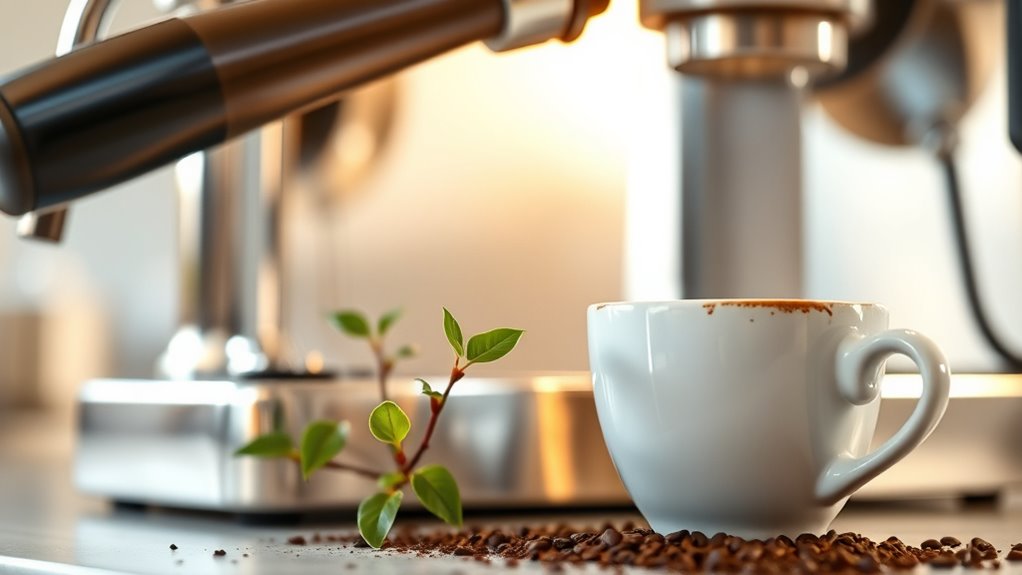
When it comes to brewing your morning cup of joe, you mightn’t think about the equipment that makes it happen—until, of course, your coffee starts tasting like dirt. Yuck!
To avoid that, stick to a cleaning schedule. Daily, dump the coffee grounds and wipe the machine. Weekly, use those cleaning tablets for a deep clean. Don’t forget monthly descaling, especially if you’ve got hard water. Regular descaling can help prevent mineral buildup that affects flavor.
And hey, keep your grinder clean to dodge that oily buildup. Trust me, following these maintenance tips keeps your coffee tasting great and your machine happy. Cheers to delicious brews!
The Impact of Bean Quality
You’ve got your coffee maker sparkling clean, but if your brew still tastes like dirt, it might be time to look at the beans themselves.
The bean variety matters a ton—Arabica beans usually win for their smooth, fruity flavors, while Robusta can taste more bitter and woody.
Plus, processing methods play a huge role. Whether it’s dry for a sweet kick or wet for that bright zing, it all affects what ends up in your cup. Additionally, the origin of the beans, such as Colombian coffee beans, can significantly influence the overall flavor profile and quality of your brew.
Understanding Roast Level
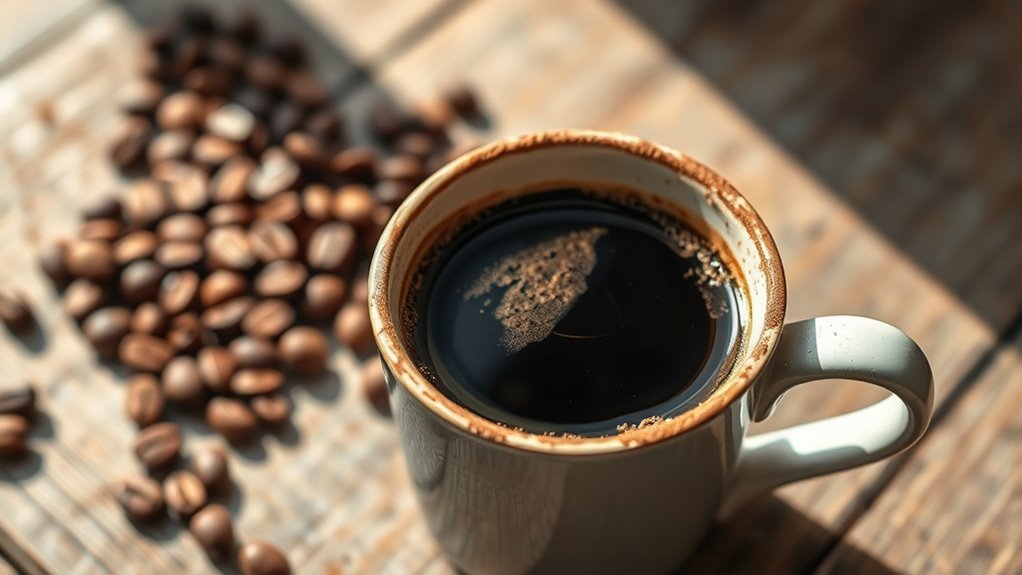
Understanding roast level can totally change your coffee experience, so let’s explore!
Whether you love light, medium, or dark roasts, each roast profile offers its own vibe. Light roasts keep those bright, fruity notes, while medium roasts balance sweetness with body.
Dark roasts? They bring the bold, smoky flavors but can tip into that “dirt-like” territory if overdone. The secret lies in the roasting time and temperature; they shape the flavor balance you crave. The right roast level can enhance the overall enjoyment of your coffee.
Next time you sip, pay attention to those flavors. You might just discover a new favorite roast that won’t taste like dirt, promise!
Evaluating Water Quality
Have you ever taken a sip of coffee and thought, “Wow, this tastes weird!”? It could be your water, buddy!
Water hardness matters—if it’s too hard, the calcium and magnesium can dull those tasty coffee notes. Too soft? Your brew might taste flat. Aim for that sweet spot with a balanced mineral content.
And let’s not forget about pH balance! Good coffee needs water with a pH between 6.5 and 7.5. Too high, and you’ll get bitterness; too low, and it’s sour city. To enhance your coffee experience, consider using filtered water that helps maintain optimal mineral levels.
Brewing Techniques That Matter
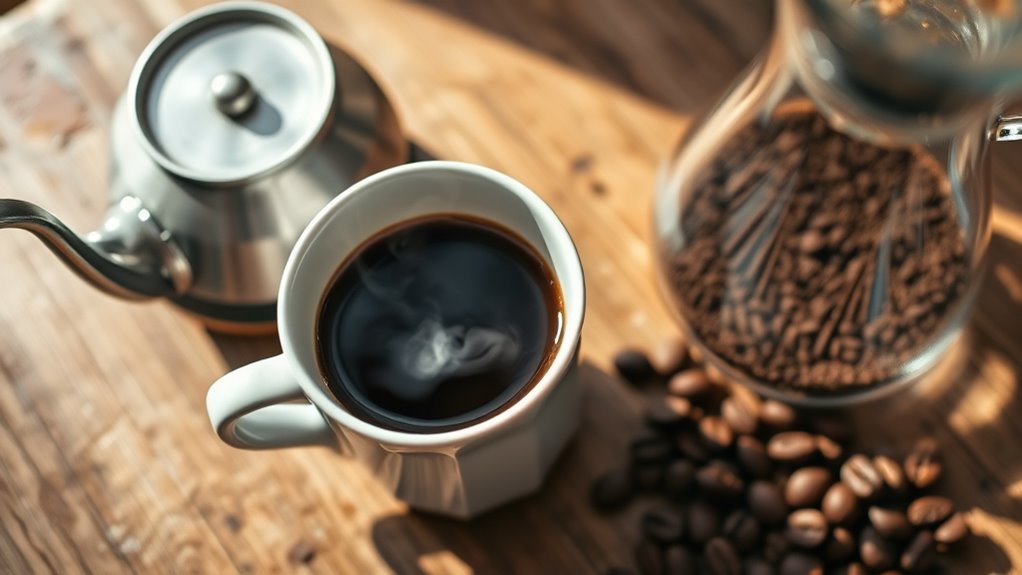
When it comes to brewing coffee, the right technique can turn your cup from “meh” to “wow!” It’s like cooking; if you don’t follow the recipe, things can go sideways real quick.
Start with grind consistency—too fine or too coarse, and you’ll end up with a funky taste. Experiment with brewing variables like steep time and water temperature.
Try pour-over for a clean cup or French press for that rich, full-bodied vibe. Don’t forget the bloom process! It helps release trapped gases. To enhance flavor extraction, remember that grind size importance plays a crucial role in preventing excessive sediment.
Your coffee deserves the best, so get brewing, and let those flavors shine! Cheers to better coffee!
Environmental Factors at Play
You might think brewing coffee is all about technique, but the environment plays a huge role too!
Just envision this: if the climate’s off, like too hot or too cold, your coffee beans can take a hit, leading to that “dirt” taste.
Soil health is super important too; if the ground’s lacking nutrients, your beans won’t deliver that rich flavor you crave.
Plus, higher altitudes can amp up the acidity and complexity—who doesn’t want that?
Additionally, the finest Kona coffee brands are known for their unique flavor profiles that result from the specific environmental conditions they grow in.
Signs of Stale Coffee Beans
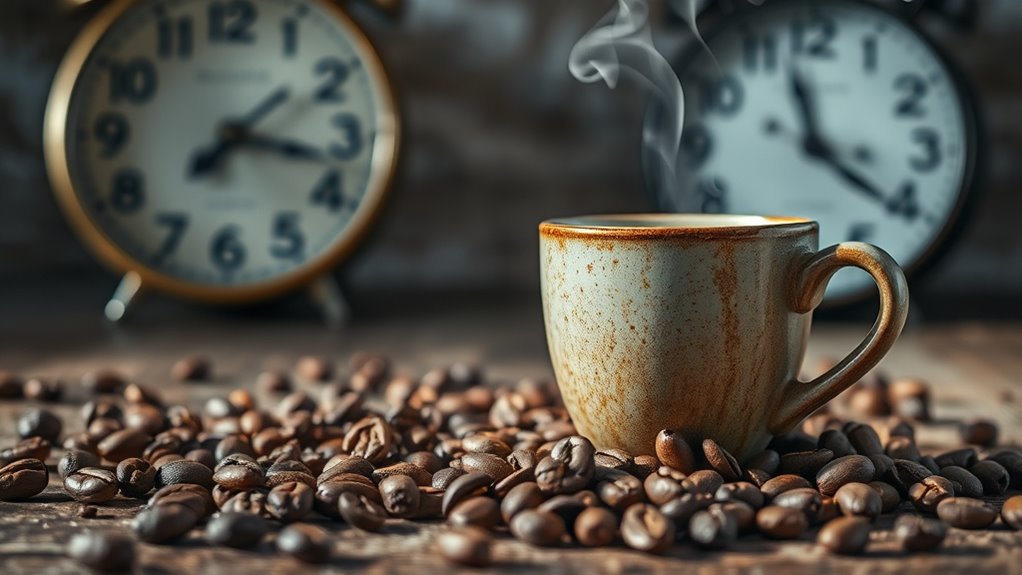
Ever brewed a cup of coffee that just tasted off, like it was missing that zing? You might be dealing with stale beans!
First off, check for aroma loss; fresh beans smell amazing, while stale ones can resemble cardboard. If your coffee’s flat and lifeless, that’s a red flag!
You’ll also notice texture changes—stale beans feel grainy and dry instead of smooth and oily. When you grind them, they might behave like rebellious teenagers, refusing to cooperate. Additionally, stale beans often result in the ultimate ground coffee that fails to deliver that rich flavor you crave.
The Role of Mineral Buildup
While enjoying your favorite cup of joe, you mightn’t realize that mineral buildup could be lurking in your coffee machine, waiting to ruin your brew.
This sneaky villain, mostly calcium and magnesium deposits from hard water, can mess with your coffee’s mineral composition. If you don’t tackle buildup prevention, you could end up with a flat, dull-tasting cup that tastes like dirt.
Plus, those pesky minerals can clog your machine, causing longer brewing times. To keep your coffee delicious, make sure to use balanced water and regularly descale your machine. Regular cleaning with vinegar cleaning tips can help prevent this buildup.
Those pesky mineral deposits can slow down your brew; keep your coffee tasty by using balanced water and descaling regularly.
Trust me; your taste buds will thank you!
Common Mistakes in Coffee Preparation
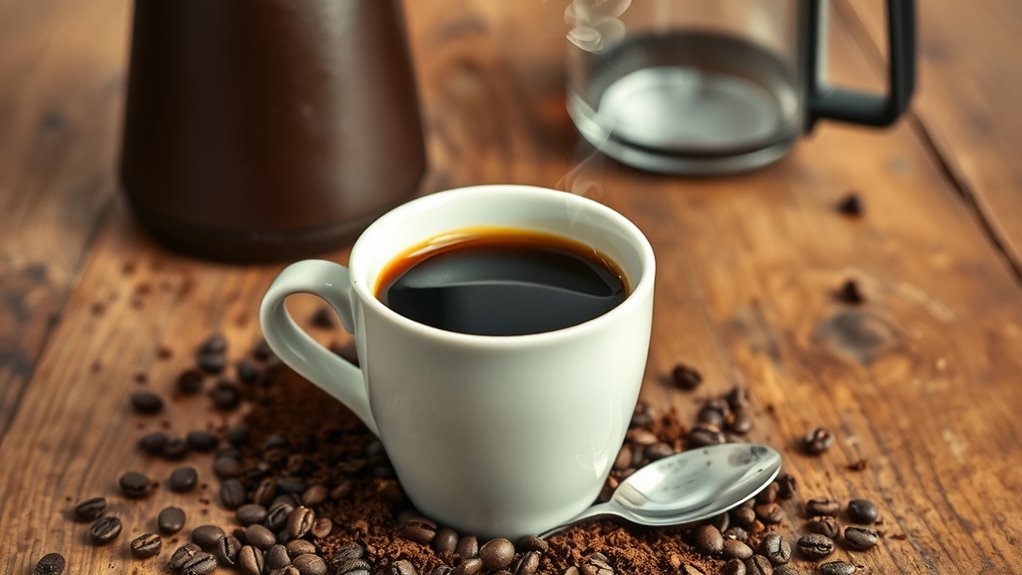
When it comes to brewing that perfect cup of coffee, a few common mistakes can turn your morning ritual into a muddy disaster.
First off, always grind your beans just before brewing; stale grounds make coffee taste flat and dirty.
Next, pay attention to grind size and extraction time—too fine and you’ll get bitterness, too coarse leads to sourness.
Also, using the right coffee-to-water ratio matters! Too much coffee makes it harsh, while too little leaves it weak.
Finally, don’t forget to clean your gear; old oils can ruin your brew. Additionally, investing in a quality grinder that produces consistent grind sizes can significantly enhance your brewing experience.
Cheers to better coffee, friends!
